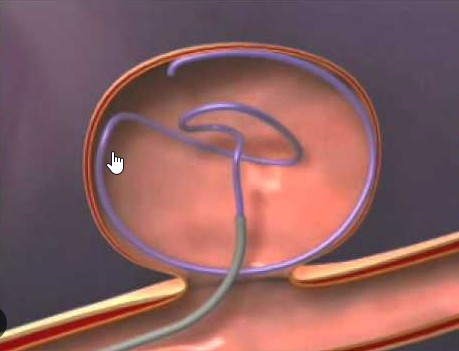RESULTS: $1.3 million [Confidential Details]
DATE: 2025
ATTORNEYS: Richard N. Shapiro, Eric K. Washburn
PARALEGAL: Paula S.
WHAT HAPPENED:
Our retired client, age 68, needed a coil embolization procedure, and the procedure was scheduled on a non-emergency basis. Coil embolization is a catheter-based procedure that allows precise occlusion of abnormal blood flow in a blood vessel. A catheter with a metallic occluding coil is inserted into an artery, usually in the groin (the femoral artery). It is then advanced to the abnormal blood vessel. Coil embolization can be done in various parts of the body, and due to a confidentiality agreement, we are not at liberty to provide particulars.

The coil is advanced through the catheter to the embolization site, burning the weakened area.
Our client underwent a CT scan, which caused one of her doctors to think there might be a clot requiring embolization. In 2021, she underwent the procedure at a Hampton Roads area hospital. During this type of embolization, doctors normally use real-time imaging to carefully advance the catheter, which is being sent through the body to embolize a clot.
The doctor conducting the procedure did not realize that a laceration of a vessel had occurred while advancing the catheter to the area for embolization, despite hemorrhaging being visible on the real-time imaging. After the embolization was successfully completed, the patient was sent to the recovery room but did not properly regain consciousness. The doctor immediately reviewed the imaging again and, at that time, saw the hemorrhaging occurring remotely from where the embolization was done. The patient was immediately returned to the operating suite, where the physician attempted to control the hemorrhaging through stenting.

Catheter access through the femoral artery
Unfortunately, the patient became hypoxic while the efforts to stent the hemorrhaging were in progress. Although the patient survived the stenting process, she never recovered and never communicated again with her adult children in the subsequent three days following the procedure. Her adult children were never able to have final words with her. They were faced with the horrible decision of withdrawing life support based on the lack of any meaningful brain activity as related to them by other physicians at the same hospital where the embolization had been done.
LEGAL STRATEGIES:
We obtained all of the medical records, including all of the imaging both during and subsequent to the procedure, and we found a highly qualified physician expert to review the materials. The physician we retained on the West Coast created a slide show to explain what had occurred and how the physician failed to notice the hemorrhaging while the coil embolization procedure had happened. According to not only this expert physician but a second physician, if the patient’s doctor had seen this hemorrhaging earlier, before the embolization, and had tried to control it, the patient would have had a substantial chance of recovery with no permanent impairment.
According to our medical experts, the medical standards of care were violated not only when the physician failed to notice the hemorrhaging before the embolization but also in choosing a method of stenting that was inappropriate for the life-threatening hemorrhage that was occurring while the physician chose the particularized stenting method that he adopted.
We attempted pre-litigation mediation with retired Virginia Beach Circuit Court Judge Thomas Shadrick, which failed. After the suit was filed and a number of depositions were conducted, Judge Shadrick again nudged the parties to work to settle the case. The case was eventually settled satisfactorily to the parties about three months before the jury trial date.
THE RESULTS: $1.3 million settlement [confidential as to details].
